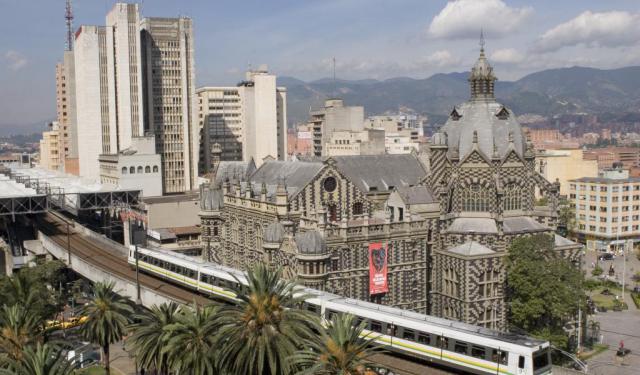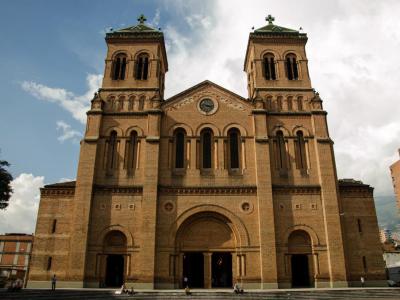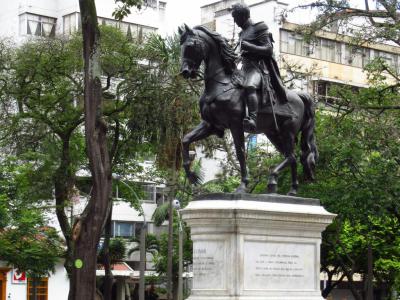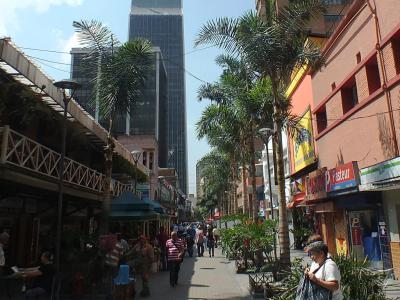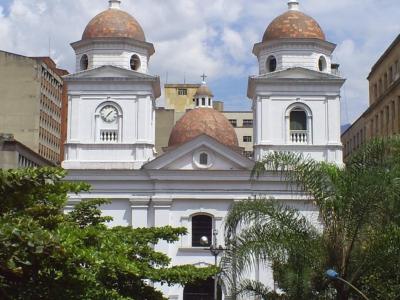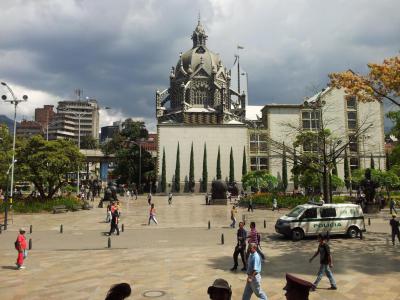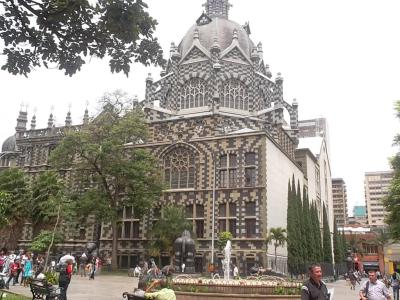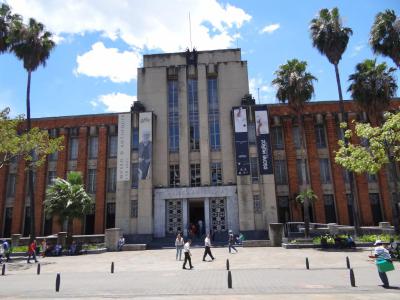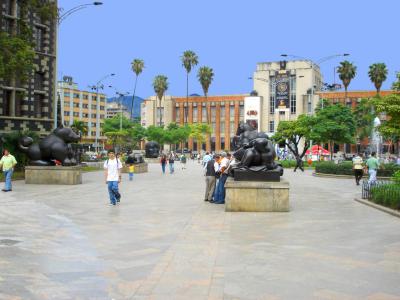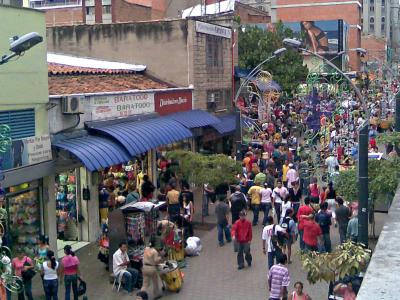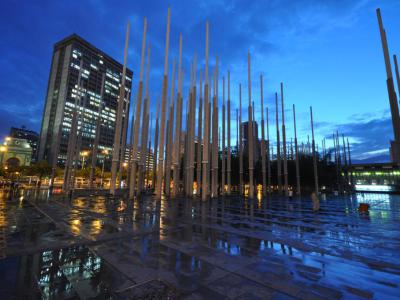Medellin Introduction Walking Tour (Self Guided), Medellin
Nestled in the heart of the Aburrá Valley, Colombia's second-largest city, Medellín, is also known colloquially by its nickname "The City of Eternal Spring" earned by its pleasant climate, ideal for outdoor activities. In recent years, having shed its troubled reputation under Pablo Escobar, the notorious drug lord in the 1980s and early 1990s, this South American metropolis has emerged as the one transformed "from fear to fascination", largely appealing to travelers interested in unique cultural experiences.
Indeed, Medellín's modern infrastructure, artistic heritage, and platter (bandeja paisa) cuisine make it the jewel in the country’s urban crown.
The precursor of the future city, a small settlement with just 80 inhabitants, was founded in 1616. It evolved through various titles before eventually becoming Medellín, inspired by a village in Spain, the birthplace of the Spanish conquistador Hernán Cortés.
As gold mining expanded, the Aburrá Valley became a vital link between mines and the provincial capital, Santa Fe de Antioquia. Rich families settled in the valley, prompting the creation of a new city in 1674.
In the mid-17th century, the city's religious heritage flourished with the construction of the Basilica of Our Lady of Candelaria. Much later, in the 1930s, another magnificent piece of ecclesiastical architecture, the Metropolitan Cathedral of Medellín, was added.
Medellín continued to grow throughout the colonial era. Its population surged in the early 20th century, driven by both industrialization and coffee exportation, making it a dynamic center of commerce and culture, gaining prominence as a hub for music, film, and literature. In the latter half of the 20th century, the city grappled with political instability, facing challenges related to drug cartels, but has since transformed into a model of urban innovation and renewal.
Today, Medellín successfully balances tradition and progress. To witness its remarkable journey you may wish to visit the Museum of Antioquia, offering a deep dive into the region's artistic and cultural legacy.
To take in the city's contemporary side, check out Carabobo Avenue, a bustling commercial thoroughfare, or Plaza Cisneros, a modern square illuminated by a mesmerizing light display at night. Also, you may wish to pose beside Botero’s grossly disproportionate sculptures in Botero Square (Plaza Botero) named after the famous local artist, Fernando Botero.
To explore "The Miracle of Medellín" firsthand and to see "The New Capital of Cool" that has emerged from a city once plagued by violence and crime to a trendy and vibrant destination, take this self-guided tour.
Indeed, Medellín's modern infrastructure, artistic heritage, and platter (bandeja paisa) cuisine make it the jewel in the country’s urban crown.
The precursor of the future city, a small settlement with just 80 inhabitants, was founded in 1616. It evolved through various titles before eventually becoming Medellín, inspired by a village in Spain, the birthplace of the Spanish conquistador Hernán Cortés.
As gold mining expanded, the Aburrá Valley became a vital link between mines and the provincial capital, Santa Fe de Antioquia. Rich families settled in the valley, prompting the creation of a new city in 1674.
In the mid-17th century, the city's religious heritage flourished with the construction of the Basilica of Our Lady of Candelaria. Much later, in the 1930s, another magnificent piece of ecclesiastical architecture, the Metropolitan Cathedral of Medellín, was added.
Medellín continued to grow throughout the colonial era. Its population surged in the early 20th century, driven by both industrialization and coffee exportation, making it a dynamic center of commerce and culture, gaining prominence as a hub for music, film, and literature. In the latter half of the 20th century, the city grappled with political instability, facing challenges related to drug cartels, but has since transformed into a model of urban innovation and renewal.
Today, Medellín successfully balances tradition and progress. To witness its remarkable journey you may wish to visit the Museum of Antioquia, offering a deep dive into the region's artistic and cultural legacy.
To take in the city's contemporary side, check out Carabobo Avenue, a bustling commercial thoroughfare, or Plaza Cisneros, a modern square illuminated by a mesmerizing light display at night. Also, you may wish to pose beside Botero’s grossly disproportionate sculptures in Botero Square (Plaza Botero) named after the famous local artist, Fernando Botero.
To explore "The Miracle of Medellín" firsthand and to see "The New Capital of Cool" that has emerged from a city once plagued by violence and crime to a trendy and vibrant destination, take this self-guided tour.
How it works: Download the app "GPSmyCity: Walks in 1K+ Cities" from Apple App Store or Google Play Store to your mobile phone or tablet. The app turns your mobile device into a personal tour guide and its built-in GPS navigation functions guide you from one tour stop to next. The app works offline, so no data plan is needed when traveling abroad.
Medellin Introduction Walking Tour Map
Guide Name: Medellin Introduction Walking Tour
Guide Location: Colombia » Medellin (See other walking tours in Medellin)
Guide Type: Self-guided Walking Tour (Sightseeing)
# of Attractions: 10
Tour Duration: 1 Hour(s)
Travel Distance: 1.9 Km or 1.2 Miles
Author: DanaOffice
Sight(s) Featured in This Guide:
Guide Location: Colombia » Medellin (See other walking tours in Medellin)
Guide Type: Self-guided Walking Tour (Sightseeing)
# of Attractions: 10
Tour Duration: 1 Hour(s)
Travel Distance: 1.9 Km or 1.2 Miles
Author: DanaOffice
Sight(s) Featured in This Guide:
- Metropolitan Cathedral of Medellín
- Bolívar Park
- Junin Street
- Basilica of Our Lady of Candelaria
- Berrío Park
- Rafael Uribe Uribe Palace of Culture
- Museum of Antioquia
- Plaza Botero (Botero Square)
- Carabobo Avenue
- Plaza Cisneros
1) Metropolitan Cathedral of Medellín (must see)
The Metropolitan Cathedral of Medellín, officially known as the Metropolitan Cathedral Basilica of the Immaculate Conception, is a Catholic cathedral dedicated to the Virgin Mary under the title of the Immaculate Conception. It was formerly called and is still known, to a lesser extent, as Villanueva Cathedral, especially during its construction to distinguish it from the Basilica of Our Lady of Candelaria, which was the seat of the Episcopal see at the time.
Designed by the French architect Émile Charles Carré (1863-1909) in a Romanesque style, the cathedral features a Latin cross floor plan with three longitudinal aisles, crossed by the transept. Its two towers reach a height of 66 meters at the spires. It is a solid brick structure, and during its construction, approximately 1,120,000 bricks, each measuring 8 cubic decimeters, were used, totaling a volume of 97,000 cubic meters. Recognized as one of the major architectural works in the country, it was declared a national monument of Colombia on March 12, 1982.
The cathedral also houses a small museum of religious art located in a room adjacent to the basilica. The collection includes about 40 paintings from the 17th, 18th, and 19th centuries, as well as 15 sculptures dating from the 18th and 19th centuries. Notably, the cathedral is home to "The Christ of Forgiveness" by Colombian artist Francisco Antonio Cano Cardona.
Designed by the French architect Émile Charles Carré (1863-1909) in a Romanesque style, the cathedral features a Latin cross floor plan with three longitudinal aisles, crossed by the transept. Its two towers reach a height of 66 meters at the spires. It is a solid brick structure, and during its construction, approximately 1,120,000 bricks, each measuring 8 cubic decimeters, were used, totaling a volume of 97,000 cubic meters. Recognized as one of the major architectural works in the country, it was declared a national monument of Colombia on March 12, 1982.
The cathedral also houses a small museum of religious art located in a room adjacent to the basilica. The collection includes about 40 paintings from the 17th, 18th, and 19th centuries, as well as 15 sculptures dating from the 18th and 19th centuries. Notably, the cathedral is home to "The Christ of Forgiveness" by Colombian artist Francisco Antonio Cano Cardona.
2) Bolívar Park
This historic Bolívar Park, inaugurated in 1892, bears the esteemed name of Simón Bolívar, the revered liberator of South America. It holds a prominent position in the city's landscape and serves as a symbol of Medellín's rich heritage and cultural significance.
Spanning two city blocks, Bolívar Park encompasses approximately 14,400 square meters, offering a harmonious blend of green and paved areas. The park's landscape features an array of native trees, adding to its natural charm. This urban haven, steeped in historical and cultural significance, has transcended its role as a mere park and become an emblematic meeting place cherished by generations of Medellín residents.
Central to the park's design is an iconic equestrian statue of Simón Bolívar, crafted by Italian sculptor Giovanni Anderlini and cast by Eugenio Maccagnani. This striking monument, installed at the park's center in 1923, pays homage to the liberator's enduring legacy. The statue portrays Bolívar astride a noble steed, a powerful symbol of his leadership and dedication to the cause of freedom.
The statue stands atop a distinguished white marble pedestal, an architectural marvel envisioned by Belgian architect Agustín Goovaerts. This pedestal, measuring 3.40 meters at the base, 2.20 meters in height, and 1.40 meters in width, bears messages engraved on its walls, thoughtfully selected by Cadavid Restrepo. Positioned on a rock and brick platform approximately 1.50 meters high, the marble pedestal carries the statue with grace and grandeur.
Spanning two city blocks, Bolívar Park encompasses approximately 14,400 square meters, offering a harmonious blend of green and paved areas. The park's landscape features an array of native trees, adding to its natural charm. This urban haven, steeped in historical and cultural significance, has transcended its role as a mere park and become an emblematic meeting place cherished by generations of Medellín residents.
Central to the park's design is an iconic equestrian statue of Simón Bolívar, crafted by Italian sculptor Giovanni Anderlini and cast by Eugenio Maccagnani. This striking monument, installed at the park's center in 1923, pays homage to the liberator's enduring legacy. The statue portrays Bolívar astride a noble steed, a powerful symbol of his leadership and dedication to the cause of freedom.
The statue stands atop a distinguished white marble pedestal, an architectural marvel envisioned by Belgian architect Agustín Goovaerts. This pedestal, measuring 3.40 meters at the base, 2.20 meters in height, and 1.40 meters in width, bears messages engraved on its walls, thoughtfully selected by Cadavid Restrepo. Positioned on a rock and brick platform approximately 1.50 meters high, the marble pedestal carries the statue with grace and grandeur.
3) Junin Street
Junín Street stands out as one of the most charming pockets in the heart of downtown Medellín. This pedestrian street exudes a delightful ambiance, beckoning visitors with its eclectic mix of shops, restaurants, and vibrant flower vendors.
Spanning from Parque Bolívar to the iconic Coltejer building, this pedestrian haven once epitomized the essence of Medellín's cultural and social life. In the 1960s and 1970s, these two beloved blocks thrived as the epicenter of popular bars, restaurants, cozy coffee shops, inviting bookstores, and chic retail boutiques. It became fashionable to "juninear," a term coined to describe the practice of visiting Junín Street late in the afternoon, not only to see but to be seen by the city's most stylish paisas.
The street buzzed with activity as people indulged in leisurely window shopping at elegant boutiques, attended captivating theater performances, and gathered in inviting cafés for spirited conversations over cups of coffee or tea. It was not uncommon to spot local celebrities gracing the street with their presence, adding to its allure and prestige.
However, as time marched forward, Calle Junín gradually lost some of its luster. The high-end retailers that once adorned its sidewalks gradually gave way to shops offering more affordable, albeit lower-quality, goods. Today, while it remains a bustling thoroughfare, many passersby traverse its length out of necessity rather than for the sheer pleasure of leisurely exploration.
Nonetheless, Junín Street retains a special place in the hearts of older generations who fondly remember its golden years.
Spanning from Parque Bolívar to the iconic Coltejer building, this pedestrian haven once epitomized the essence of Medellín's cultural and social life. In the 1960s and 1970s, these two beloved blocks thrived as the epicenter of popular bars, restaurants, cozy coffee shops, inviting bookstores, and chic retail boutiques. It became fashionable to "juninear," a term coined to describe the practice of visiting Junín Street late in the afternoon, not only to see but to be seen by the city's most stylish paisas.
The street buzzed with activity as people indulged in leisurely window shopping at elegant boutiques, attended captivating theater performances, and gathered in inviting cafés for spirited conversations over cups of coffee or tea. It was not uncommon to spot local celebrities gracing the street with their presence, adding to its allure and prestige.
However, as time marched forward, Calle Junín gradually lost some of its luster. The high-end retailers that once adorned its sidewalks gradually gave way to shops offering more affordable, albeit lower-quality, goods. Today, while it remains a bustling thoroughfare, many passersby traverse its length out of necessity rather than for the sheer pleasure of leisurely exploration.
Nonetheless, Junín Street retains a special place in the hearts of older generations who fondly remember its golden years.
4) Basilica of Our Lady of Candelaria
The Basilica of Our Lady of Candelaria, affectionately known as La Candelaria Church is a venerable tribute to the Virgin Mary, honored under the title of Virgin of Candelaria. La Candelaria Church is celebrated as the oldest church in Medellín, a testament to its enduring historical significance.
Throughout its long history, this church has played various roles, including serving as the church of the Archdiocese of Medellín from 1868 to 1931, when this ecclesiastical distinction was passed on to the Cathedral Basilica of the Immaculate Conception. La Candelaria Church is a striking blend of colonial architecture with a touch of Neoclassical style, offering visitors a glimpse into Colombia's rich architectural heritage.
The building itself, constructed with stone and mortar, has witnessed the passage of time and undergone various alterations, with materials of different origins integrated into its structure. These layers of history only add to the church's charm and character.
On December 8, 1970, Pope Paul VI bestowed upon La Candelaria Church the honorable title of Minor Basilica, a recognition of its spiritual and cultural significance. This title is a testament to the church's enduring role as a place of devotion and worship for the faithful.
In 1997, the basilica underwent a significant renovation, breathing new life into its ancient walls and preserving its cultural heritage. The culmination of these efforts occurred on July 31, 1998, when, by resolution 0795, the building was proudly declared a National Monument of Colombia, securing its place as a cherished symbol of the nation's history and faith.
Inside the basilica, the main altar, resplendent in gold-painted wood, stands as a focal point of reverence. Above the altar, a painting of the Virgin of Candelaria, the patron saint of the town, graces the sanctuary, serving as a source of spiritual inspiration for all who visit.
Throughout its long history, this church has played various roles, including serving as the church of the Archdiocese of Medellín from 1868 to 1931, when this ecclesiastical distinction was passed on to the Cathedral Basilica of the Immaculate Conception. La Candelaria Church is a striking blend of colonial architecture with a touch of Neoclassical style, offering visitors a glimpse into Colombia's rich architectural heritage.
The building itself, constructed with stone and mortar, has witnessed the passage of time and undergone various alterations, with materials of different origins integrated into its structure. These layers of history only add to the church's charm and character.
On December 8, 1970, Pope Paul VI bestowed upon La Candelaria Church the honorable title of Minor Basilica, a recognition of its spiritual and cultural significance. This title is a testament to the church's enduring role as a place of devotion and worship for the faithful.
In 1997, the basilica underwent a significant renovation, breathing new life into its ancient walls and preserving its cultural heritage. The culmination of these efforts occurred on July 31, 1998, when, by resolution 0795, the building was proudly declared a National Monument of Colombia, securing its place as a cherished symbol of the nation's history and faith.
Inside the basilica, the main altar, resplendent in gold-painted wood, stands as a focal point of reverence. Above the altar, a painting of the Virgin of Candelaria, the patron saint of the town, graces the sanctuary, serving as a source of spiritual inspiration for all who visit.
5) Berrío Park
Berrío Park is more than just an urban plaza; it's a vibrant meeting place for locals and a significant landmark for visitors. Originally established in 1649, the park was initially referred to as the Main Square, serving as a gathering point for parishioners before and after attending the Eucharist. However, between 1784 and 1892, the plaza transformed into a bustling public market, bearing witness to numerous executions and significant political announcements.
A pivotal moment in the park's history occurred on June 29, 1895, when the statue of Pedro Justo Berrío, a prominent conservative politician and former governor of Antioquia, was inaugurated. This event led to the renaming of the square to Berrío Park. The statue, created by Italian artist Giovanni Anderlini in Rome, is a fitting tribute to Berrío, featuring symbols of a shield, cane, and sword, along with an inscription commemorating his integrity and modesty. The statue's pedestal also bears his birth and death dates.
The park has seen several changes over the years. Initially, it featured a stone basin from 1789, later replaced by the city's first metal water fountain in 1853. Interestingly, this fountain was relocated to the José Félix de Restrepo plaza when the Berrío statue found its place.
In addition to the notable Berrío statue, Berrío Park boasts several captivating sculptures. "The Challenge," a striking bronze and concrete sculpture standing at 18 meters tall, was generously donated by Banco Popular in 1981 and crafted by Rodrigo Arenas Betancourt. In the south-west corner, you'll find the "Female Torso," an iconic bronze sculpture by the renowned Colombian artist Fernando Botero, affectionately known as "La Gorda" (The Fat Lady). La Gorda, gifted to the park in 1987, was Botero's first large bronze sculpture donated to Colombia. It stands 3.3 meters high and 2.4 meters wide, facing the Bank of the Republic.
Additionally, across the park, you can explore two captivating murals depicting the history of Antioquia, created by the talented Colombian artist Pedro Nel Gómez in 1956.
A pivotal moment in the park's history occurred on June 29, 1895, when the statue of Pedro Justo Berrío, a prominent conservative politician and former governor of Antioquia, was inaugurated. This event led to the renaming of the square to Berrío Park. The statue, created by Italian artist Giovanni Anderlini in Rome, is a fitting tribute to Berrío, featuring symbols of a shield, cane, and sword, along with an inscription commemorating his integrity and modesty. The statue's pedestal also bears his birth and death dates.
The park has seen several changes over the years. Initially, it featured a stone basin from 1789, later replaced by the city's first metal water fountain in 1853. Interestingly, this fountain was relocated to the José Félix de Restrepo plaza when the Berrío statue found its place.
In addition to the notable Berrío statue, Berrío Park boasts several captivating sculptures. "The Challenge," a striking bronze and concrete sculpture standing at 18 meters tall, was generously donated by Banco Popular in 1981 and crafted by Rodrigo Arenas Betancourt. In the south-west corner, you'll find the "Female Torso," an iconic bronze sculpture by the renowned Colombian artist Fernando Botero, affectionately known as "La Gorda" (The Fat Lady). La Gorda, gifted to the park in 1987, was Botero's first large bronze sculpture donated to Colombia. It stands 3.3 meters high and 2.4 meters wide, facing the Bank of the Republic.
Additionally, across the park, you can explore two captivating murals depicting the history of Antioquia, created by the talented Colombian artist Pedro Nel Gómez in 1956.
6) Rafael Uribe Uribe Palace of Culture
The Rafael Uribe Uribe Palace of Culture, designed by Belgian architect Agustín Goovaerts, showcases the exquisite Gothic Revival style. The palace takes its name from Rafael Uribe Uribe, a distinguished General affiliated with the Colombian Liberal Party.
This distinguished establishment plays a vital role in promoting cultural activities, offering a diverse array of programs, including concerts, conferences, and art exhibitions. As a testament to its cultural significance, the Palace of Culture has earned the prestigious status of a national monument of Colombia and generously opens its doors to the public.
Visitors to this cultural hub can explore a plethora of offerings, such as the historical and photographic archive, a music and sound archive, a charming café, a well-stocked library, a comprehensive documentation center, a captivating permanent art gallery, and the intriguing "Rafael Uribe Uribe" Museum room. The large dome gracing the building serves a multifunctional purpose, transforming into an auditorium and a projection room, where movie screenings take place. The palace boasts four floors, a central courtyard, and a rooftop observation area, providing diverse spaces for cultural and intellectual pursuits.
Notably, the dome's structural design is a marvel of mathematical precision. The metal supports, imported from Belgium in 1928, were assembled using a technique inspired by New York skyscrapers. Bolts and nuts were heated until incandescent, creating a tightening effect that fortified the structure without the need for welding. This engineering feat not only enhances the building's resilience but also stands as a testament to human ingenuity.
This distinguished establishment plays a vital role in promoting cultural activities, offering a diverse array of programs, including concerts, conferences, and art exhibitions. As a testament to its cultural significance, the Palace of Culture has earned the prestigious status of a national monument of Colombia and generously opens its doors to the public.
Visitors to this cultural hub can explore a plethora of offerings, such as the historical and photographic archive, a music and sound archive, a charming café, a well-stocked library, a comprehensive documentation center, a captivating permanent art gallery, and the intriguing "Rafael Uribe Uribe" Museum room. The large dome gracing the building serves a multifunctional purpose, transforming into an auditorium and a projection room, where movie screenings take place. The palace boasts four floors, a central courtyard, and a rooftop observation area, providing diverse spaces for cultural and intellectual pursuits.
Notably, the dome's structural design is a marvel of mathematical precision. The metal supports, imported from Belgium in 1928, were assembled using a technique inspired by New York skyscrapers. Bolts and nuts were heated until incandescent, creating a tightening effect that fortified the structure without the need for welding. This engineering feat not only enhances the building's resilience but also stands as a testament to human ingenuity.
7) Museum of Antioquia (must see)
The Museo de Antioquia has a rich history that dates back to its inception in November 1881. Its early years were marked by various challenges, including periods of crisis, closures, and reopenings, and it operated under the name of the Zea Museum.
During its early years, the museum earned recognition as the first in Antioquia and the second in Colombia. However, it wasn't until the generous support of the renowned artist Fernando Botero that the institution truly began to flourish, eventually becoming an iconic center of art in Medellín.
Fernando Botero played a pivotal role in the museum's development by donating a significant portion of his own artworks and providing both financial and artistic assistance. In 2000, under Botero's guidance, the museum found a new home in the historic Municipal Palace and adopted its current name, Museo de Antioquia.
Within the museum's walls, visitors can explore a diverse array of art forms, including drawings, paintings, sculptures, and objects of historical significance.
The Museo de Antioquia proudly houses permanent works by local artists such as Debora Arango and Pedro Nel Gomez, whose contributions illuminate the regional artistic landscape. However, the museum's crowning jewel is the extensive collection of over five thousand artistic pieces by Fernando Botero, making it the largest repository of his works in the world.
To ensure accessibility to visitors from around the globe, some of the artworks are accompanied by descriptions in English.
During its early years, the museum earned recognition as the first in Antioquia and the second in Colombia. However, it wasn't until the generous support of the renowned artist Fernando Botero that the institution truly began to flourish, eventually becoming an iconic center of art in Medellín.
Fernando Botero played a pivotal role in the museum's development by donating a significant portion of his own artworks and providing both financial and artistic assistance. In 2000, under Botero's guidance, the museum found a new home in the historic Municipal Palace and adopted its current name, Museo de Antioquia.
Within the museum's walls, visitors can explore a diverse array of art forms, including drawings, paintings, sculptures, and objects of historical significance.
The Museo de Antioquia proudly houses permanent works by local artists such as Debora Arango and Pedro Nel Gomez, whose contributions illuminate the regional artistic landscape. However, the museum's crowning jewel is the extensive collection of over five thousand artistic pieces by Fernando Botero, making it the largest repository of his works in the world.
To ensure accessibility to visitors from around the globe, some of the artworks are accompanied by descriptions in English.
8) Plaza Botero (Botero Square) (must see)
Botero Square is a charming 7,000 square meter open-air park that serves as a captivating showcase for 23 sculptures crafted by the renowned Colombian artist Fernando Botero. These exquisite sculptures, generously donated by Botero himself, were a pivotal contribution to the museum's renovation in 2004.
Situated within the heart of Medellín, Colombia, in an area affectionately known as the "Old Quarter," Botero Square stands as a testament to the artist's deep connection to his homeland and his commitment to enriching his country's cultural landscape. Throughout his illustrious career, Fernando Botero has made significant donations to various museums, leaving an indelible mark on Colombia's art scene.
Botero's sculptures, gracefully displayed in Botero Square, are crafted exclusively from bronze. Many of these sculptures once graced the halls of prestigious museums in Paris, New York, and Madrid before finding their rightful place in Medellín. Characteristically, the sculptures bear simple names, reflecting their timeless themes - "The Hand," "Eve," "Maternity," "Man on Horseback," and "Roman Soldier," to name just a few.
One enchanting aspect of Botero Square is the "Botero legend" that suggests rubbing the statues brings love and good fortune. As visitors stroll among these captivating sculptures, they have the opportunity not only to admire Botero's artistic genius but also to engage in a tradition that adds an extra layer of charm to this cultural haven.
Situated within the heart of Medellín, Colombia, in an area affectionately known as the "Old Quarter," Botero Square stands as a testament to the artist's deep connection to his homeland and his commitment to enriching his country's cultural landscape. Throughout his illustrious career, Fernando Botero has made significant donations to various museums, leaving an indelible mark on Colombia's art scene.
Botero's sculptures, gracefully displayed in Botero Square, are crafted exclusively from bronze. Many of these sculptures once graced the halls of prestigious museums in Paris, New York, and Madrid before finding their rightful place in Medellín. Characteristically, the sculptures bear simple names, reflecting their timeless themes - "The Hand," "Eve," "Maternity," "Man on Horseback," and "Roman Soldier," to name just a few.
One enchanting aspect of Botero Square is the "Botero legend" that suggests rubbing the statues brings love and good fortune. As visitors stroll among these captivating sculptures, they have the opportunity not only to admire Botero's artistic genius but also to engage in a tradition that adds an extra layer of charm to this cultural haven.
9) Carabobo Avenue
Carabobo Avenue, officially referred to as Carrera 52, is a prominent thoroughfare in Medellín, which cuts through the heart of the city, running from the Medellín River in the south to the northern sections. This avenue serves as a vital transportation route connecting various key urban landmarks, institutions, and cultural attractions, playing an integral role in the city's urban landscape.
The avenue derives its name from the significant historical reference to the two Battles of Carabobo, symbolizing a tribute to the city's historical heritage and patriotic significance.
A noteworthy transformation occurred along Carabobo Avenue between October 2005 and October 2006. The segment of the avenue between San Juan and Greiff was pedestrianized, providing a tranquil escape from vehicular traffic and exhaust fumes. The rest of the avenue saw an expansion of pedestrian platforms, creating an inviting space for residents and visitors alike.
Carabobo Avenue offers a delightful experience for pedestrians, with various attractions along the way. Stroll along this vibrant avenue, where you can immerse yourself in the city's culture and energy. Enjoy the lively atmosphere filled with street musicians, vendors selling fruits and vegetables, clothing, hats, and more. The avenue is a bustling hub of activity, offering a delightful escape from the hustle and bustle of vehicular traffic. Whether you're exploring the street stands, shops, or department stores lining the avenue, Carabobo Avenue is a true joy to experience.
The avenue derives its name from the significant historical reference to the two Battles of Carabobo, symbolizing a tribute to the city's historical heritage and patriotic significance.
A noteworthy transformation occurred along Carabobo Avenue between October 2005 and October 2006. The segment of the avenue between San Juan and Greiff was pedestrianized, providing a tranquil escape from vehicular traffic and exhaust fumes. The rest of the avenue saw an expansion of pedestrian platforms, creating an inviting space for residents and visitors alike.
Carabobo Avenue offers a delightful experience for pedestrians, with various attractions along the way. Stroll along this vibrant avenue, where you can immerse yourself in the city's culture and energy. Enjoy the lively atmosphere filled with street musicians, vendors selling fruits and vegetables, clothing, hats, and more. The avenue is a bustling hub of activity, offering a delightful escape from the hustle and bustle of vehicular traffic. Whether you're exploring the street stands, shops, or department stores lining the avenue, Carabobo Avenue is a true joy to experience.
10) Plaza Cisneros
Plaza Cisneros, also known as Lights Park, stands as a prominent public space in Medellín. This vibrant plaza derives its name from the Cuban engineer Francisco Javier Cisneros, a visionary leader who played a pivotal role in overseeing the construction of the Antioquia Railway.
What sets Plaza Cisneros apart is its captivating display of light. Here, an artificial forest of 300 towering light poles, each reaching heights of up to 24 meters, graces the plaza, casting a luminous glow upon the surroundings. These towering beacons create a mesmerizing spectacle that transforms the plaza into a radiant wonderland, particularly after the sun sets.
While today it stands as a striking beacon of illumination, Plaza Cisneros has a rich history. In times past, it served as the bustling main marketplace of the city, a vibrant hub of commerce and activity.
The plaza underwent a remarkable transformation during its renovation, which was part of a broader revitalization effort known as "Medellín is Light." This visionary project aimed to rejuvenate the area and redefine its identity, and it certainly succeeded. During daylight hours, Plaza Cisneros may appear unassuming, but as darkness descends, the 300 majestic light poles scattered throughout the plaza come to life, casting a radiant glow that captivates the senses.
Beyond its luminous allure, the plaza boasts remarkable architectural gems. Among them, the Biblioteca EPM stands out, a striking library characterized by its angular design and modern aesthetics. Within its walls, visitors can explore a small museum and enjoy the convenience of free Wi-Fi, making it not only a cultural destination but also a functional and accessible space for the community.
What sets Plaza Cisneros apart is its captivating display of light. Here, an artificial forest of 300 towering light poles, each reaching heights of up to 24 meters, graces the plaza, casting a luminous glow upon the surroundings. These towering beacons create a mesmerizing spectacle that transforms the plaza into a radiant wonderland, particularly after the sun sets.
While today it stands as a striking beacon of illumination, Plaza Cisneros has a rich history. In times past, it served as the bustling main marketplace of the city, a vibrant hub of commerce and activity.
The plaza underwent a remarkable transformation during its renovation, which was part of a broader revitalization effort known as "Medellín is Light." This visionary project aimed to rejuvenate the area and redefine its identity, and it certainly succeeded. During daylight hours, Plaza Cisneros may appear unassuming, but as darkness descends, the 300 majestic light poles scattered throughout the plaza come to life, casting a radiant glow that captivates the senses.
Beyond its luminous allure, the plaza boasts remarkable architectural gems. Among them, the Biblioteca EPM stands out, a striking library characterized by its angular design and modern aesthetics. Within its walls, visitors can explore a small museum and enjoy the convenience of free Wi-Fi, making it not only a cultural destination but also a functional and accessible space for the community.
The Most Popular Cities
/ view all
